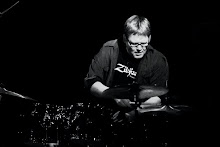Quick one today. I've been busy trying to get my harp chops more together so not so many posts lately, will try to improve in the future!
I was just watching some great Art Taylor footage at Four On the Floor and it got me thinking about something I often talk about in ensembles I coach. Mr. Taylor (at least in the first tune I saw, the clip itself is 30 minutes long, so there's something to look forward to seeing in its entirety) rarely touches his left hand side cymbal, yet he creates various moods and shapes throughout the piece. An important role of the drummer in any ensemble, which I feel sometimes gets pushed aside somewhat, is that he/she is always signaling events within a performance. Some examples (in a Jazz context) might be the intro, the in head, the start of the solos, the different soloists, and the out head. Often I really don't hear the drummer making any textural or volume differences between these sections and the piece tends to sound monotone.
I feel ideally what we want is for someone who has never heard any of this music before to be able to understand the above events I've described purely by the actions the drummer takes. Let's talk about a couple of ways of outlining different sections of a tune.
1. Rapid volume changes- One of the things I noticed that Art Taylor did in the tune I saw is that even though he didn't switch cymbals for each soloist, he did change the volume level of his cymbal throughout the piece to cause a texture change. This is very handy when you only have one cymbal. (Although you can also have your hi-hat function as any type of cymbal as well. Roy Haynes does this beautifully on "Now He Sings, Now He Sobs" where the flat ride and the hi-hats are the only cymbal colours in his set up.) Also check out how Art Blakey often smacks his left hand cymbal on beat one of a solo chorus, then mutes it with the same hand while still keeping quiet time on the right hand cymbal. This way we get the signal that the head is over and the soloist is starting, but he also gets that loud cymbal out of the way of the soloist.
It doesn't always have to be a loud to soft change either. Listen to "Japanese Folk Song " by Wayne Shorter (I posted it on December 5th) and once the head is over, Elvin really plays very aggressively! It sort of sounds like we've left the room that's the in head, and now he's kicking down the door to the blowing! Very effective!
2. Changing cymbals- This is probably the most common and easiest way of signally changes between soloists and sections, however, it is most effective when you know the form of the tune you're playing! Even if you're reading or playing by ear, really try to be aware of the form. Even if you miss the start of the next soloists's chorus (and nine times out of ten they will start on or near the start of the form), switching cymbals a bar or two in isn't a disaster. (you could be signaling the same surprise the listener might feel when a solo is quite short, for example.)
3. Changing comping textures- Another great thing I noticed in the Art Taylor footage was how when he went from the Tenor to the piano solo, even though he didn't change cymbals he went from quite prominent bass drum/open snare comping to mainly a click on beat 4 and very quiet bass drum. You could also switch from mainly snare to tom comping as well (although we'll talk about some exceptions to that later).
4. Changing implements- Going from brushes to sticks is a great way to let the listener know the head is over and the soloing has started. It's also a great way of creating less volume for quieter instruments so it works well to switch to brushes for a piano or bass solo.
5. A couple of more things about bass solos- Bass is not only usually the quietest thing in the band, it's also the instrument that gets lost most easily due to low frequencies being harder to hear. (This is even true of electric bass, where volume isn't as much of an issue.) So it's generally a good idea to thin out the texture of your timekeeping as well as the volume. Don't thin out the strength of the time or the commitment to the form though. If anything, you need to be even more on the case with this stuff because the bassist doesn't have anyone walking quarter notes for them. The bass player has been supporting everyone throughout the tune, so it's important to return the favour when it's their turn to solo! Also, watch out not to play too much toms or bass drum, or you're heading right into their frequency range and it will be even harder to hear what they're doing.
In closing, I thought I'd post the first part of this amazing documentary on Lenny Breau. The rest of it you can find on youtube. My only criticism with what I've seen so far is that a lot of the people playing with him aren't credited (e.g. the great Winnipeg based drummer Reg Kelln) because it also is a great snapshot of the people who playing Jazz in Canada in the 60s and 70s.
Anyway, check it out, it's killing!

You gave nice post to us. Thanks for spending the time to discuss this, I feel strongly about it and love learning more.
ReplyDeleteDrum programs